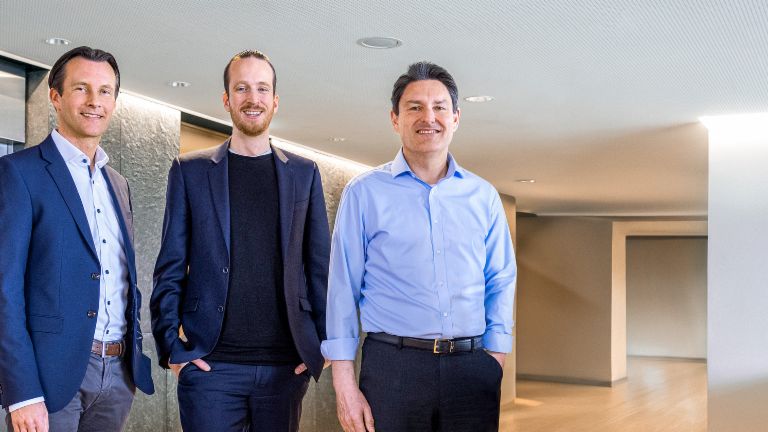How portfolio valuation works in receivables purchasing.
Before a receivables purchase goes ahead, buyer and seller first have to agree on a purchase price. To determine as fair a purchase price as possible, EOS deploys human expertise and modern technology to put a value on the receivables portfolio.
- The valuation of receivables packages is a complex process that results in an appropriate purchase price.
- Experts at EOS scrutinize every little aspect of the portfolio to determine the risk of the intended receivables purchase.
- This process makes use of algorithms and the expertise of trained analysts.
As part of the risk management function, the Operational Debt Purchase Team works with specialists in methods and analysis to thoroughly scrutinize around 800 receivables packages a year. At the end of what is a complex process, a purchase price can be recommended. “These kinds of portfolios can contain up to a million receivables. Therefore, we basically look at it as we would a shoal of fish. We need to understand what makes the shoal tick and what direction it is swimming in, not the direction of each individual fish,” says Matthias Schmidt, Head of Operational Debt Purchase at EOS Group.

The more accurate the evaluation, the lower the financial risk.
“Unlike fiduciary collection, we are taking a substantial risk with a debt purchase. Because once the purchase has been completed the money is gone,” says Matthias. So that he and his team can have a look beforehand at the portfolio being negotiated, the seller provides an anonymized package of raw data in the form of an Excel file. Every line in the file represents an outstanding receivable and defaulting payer.
Have they ever got it wrong with their recommendations? “Yes, definitely!” Matthias admits. “But our success rate is pretty good.” Matthias actually has a doctorate in physics. After graduating he initially worked in the field of semi-conductor technology development, then as a consultant working mainly with ‘bad banks’. “And now my job is to find out what makes receivables portfolios tick,” he says. What all his previous roles have in common is the need to deal with complex subject matter. “I am someone who loves to understand the background,” he says. It’s an essential quality when evaluating portfolios. Because ultimately, it’s about making a decision involving a lot of money.

The raw data tell the story.
The information provided can vary considerably. “In a worst-case scenario, all we have is the amount of the individual receivables. But we also get datasets with 50 to 60 columns of information, for example, on how long the debt has been overdue and when it will become time-barred, or where the defaulting payer lives. The more rock solid the information, the better the chance of determining a purchase price that is a fair reflection of the receivable and the portfolio.
Because apart from quantity, the quality of the data also plays an important role: “In some countries you might get seven phone numbers for each receivable. You don’t know which, if any, is current until you have tried them all and got lucky,” says Matthias. “Or you don’t know if the information is still up-to-date. Obviously, that depends. Details provided ten years ago when a loan was taken out might no longer be valid.” Transcription errors are also an issue, for example if ownership of the receivable changes hands, two banks merge, or systems are migrated to a new system. After reviewing the data, Matthias and his team ask themselves two questions: What do we know, and sometimes much more importantly, what do we not know?
“To really become aware of the story, sometimes it’s enough just to produce a graphic representation of the given parameters. Here too, as so often in life, making a drawing can help,” says Matthias. “Doing this makes it easier to notice any anomalies.” Another factor is the context in which the portfolio is being sold. For example, is it a portfolio from a period of crisis? When was the last time a payment was actually made, and what do the accounting entries and dates mean? What is the seller’s history and what happened on the market at that time? What is the percentage of insolvencies involved? Are there new laws that affect the way we work, and what does this do to the nature or the story of the portfolio that we want to continue writing?” With every question the profile of the debt portfolio becomes more detailed. To drill down even deeper, he and his team then divide the receivables into qualitative and quantitative groups: “It is at this point that the portfolio acquires something of a human aspect. Because each portfolio tells its own story and is completely unique,” he adds.

An algorithm could never develop a sense of the story of the portfolio the way an analyst does.
Past experience helps determine price.
Next, the EOS analysts look for empirical data from the past from the extensive pool of data it has at its disposal. For the purposes of the valuation, the analysts ask the following questions: Which benchmark has a similar story to tell, or in other words, has EOS already purchased a comparable portfolio in the same sector or region? How did the realization of the portfolio turn out in that particular case? The analysts use this historical data to develop benchmark averages against which new portfolios must be measured, albeit against the background of current, or much more importantly, future circumstances. The evaluation also considers whether there have been upheavals or changes in the political environment in the interim. “Debt collection is constantly changing, so of course we have to take that into account and adjust the forecast accordingly, based on the benchmark,” says Matthias.
In special cases the team falls back on algorithms, which are used to process complex data. A good result, however, does not depend on raw data alone. The human factor also plays an important role in the evaluation: “An algorithm could never develop a sense of the story of the portfolio the way an analyst does,” says Matthias. From a certain point you also need intuition, which is based on experience.
If you would like to sell your receivables please don’t hesitate to contact us.
EOS Deutscher Inkasso-Dienst GmbH
Steindamm 71
20099 Hamburg
Teléfono: +49 40 2850 0
Fax: +49 40 2850 1400
Photo credits: Benne Ochs (4)
Explora más de EOS



